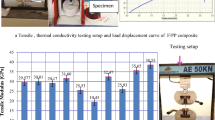New commercial and military aircraft components are often manufactured using advanced composite materials. Fuel is stored in the wing and horizontal tail structures of aircraft for prolonged periods of time. The use of alternative turbine engine fuels as substitutes for such kerosene-based fuels as Jet-A is increasing steadily. However, the studies related to effects of the fuels on the composite structure of aircraft are limited in number. This research was meant to investigate the effects that contacting alternative turbine fuels might have on the mechanical properties of a composite structure. Three different test settings were prepared — 0 and 90° orientation tensile and a modified wedge ones. An IM7 8552 unidirectional carbon fiber/epoxy prepreg was used to manufacture test specimens. They were soaked in various kinds of turbine engine fuels: neat Jet-A, 50/50 blend of Jet-A and hydroprocessed renewable jet (HRJ) (Jet-A/HRJ), Fischer-Tropsch (FT), 50/50 blend of synthetic jet fuel S8 and Fischer-Tropsch (FT) (S8/FT), hydrogenated esters and fatty acids (HEFA) fuels, and synthesized iso-paraffin fuels (SIP) for a period of 45 days and then tested. The test data obtained were analyzed to detect any significant degradation of the mechanical properties of test specimens.








Similar content being viewed by others
References
N. Guermazi, A. B. Tarjem, I. Ksouri, and H. F. Ayedi, “On the durability of FRP composites for aircraft structures in hygrothermal conditioning,” Composites Part B: Engineering, 85, 294-304 (2016).
X. He, “A review of finite element analysis of adhesively bonded joints,” International Journal of Adhesion and Adhesives, 31, No. 4, 248-264 (2011).
M. D. Banea and L. F. da Silva, “Adhesively bonded joints in composite materials: an overview,” Proceedings of the Institution of Mechanical Engineers, Part L: Journal of Materials: Design and Applications, 223, No. 1, 1-8 (2009).
N. Yilmaz and A. Atmanli, “Sustainable alternative fuels in aviation,” Energy, 140, 1378-1386 (2017).
M. R. McWilliams, “Ensuring surety of supply through sustainable aviation fuels,” Air & Space Power Journal, 31, No. 1, 81-86 (2017).
B. Song, X. Wang, and H. Zhang, “The aircraft composite integral fuel tank fire safety performance analysis and shrinkage ratio simulation calculation,” Procedia Engineering., 52, 320-324 (2013).
F. Wang, S. Jia, Y. Wang, and Z. Yue, “Impact response study on covering cap of aircraft big-size integral fuel tank,” Applied Composite Materials, 23, No. 5, 953-972 (2016).
G. Kim and R. Sterkenburg, “Investigating the effects aviation fluids have on the flatwise compressive strength of Nomex® honeycomb core material,” Journal of Sandwich Structures & Materials, 1099636219836645 (2019).
Y. Aoki, K. Yamada, and T. Ishikawa, “Effects of water absorption and temperature on compression after impact (cal) strength of CFRP laminates,” in: 16th International Conference on Composite Materials, Tokyo, Japan (2007).
D. J. Kumar, A. K. Singh, and R. P. Singh, “Accelerated environmental degradation of fiber reinforced composites by boiling water,” Processing, Properties and Performance of Composite Materials, 4, 2652-2658 (2008).
Y. Zhong and S. C. Joshi, “Initiation of structural defects in carbon fiber reinforced polymer composites under hydrothermal environments,” Journal of Composite Materials, 50, No. 8, 1085-1097 (2016).
J. Meng and Y. Wang, “A review on artificial aging behaviors of fiber reinforced polymer-matrix composites,” in : Proceeding of the International Symposium on Materials Application and Engineering (SAME 2016), Chiang Mai, Thailand (2016).
X. J. Lv, Q. Zhang, X. F. Li, and G. J. Xie, “Study of the influence of immersion on the carbon fiber/epoxy composites,” Journal of Reinforced Plastics and Composites, 27, No. 6, 659-666 (2008).
G. Kim, R. Sterkenburg, and W. Tsutsui, “Investigating the effects of fluid intrusion on Nomex® honeycomb sandwich structures with carbon fiber facesheets,” Composite Structures, 206, 535-549 (2018).
C. Khoury, R. Sterkenburg, P. Wang, and S. Dubikovsky, “Investigating the effects of deicing fluids on the structural properties of bonded composites aircraft structures,” in: Proceedings of the 7th Asian-Australian Conference on Composite Materials, Taipei, Taiwan (2010).
A. Kremmel, D. Danzler, P. Wang, and R. Sterkenburg, “Investigating the chemical resistance of adhesively bonded composite material Joints in the presence of various fluids found in or around aircraft structures,” in: Proceedings of the 2011 ATEC Conference, Orlando, Florida (2011).
R. Sterkenburg, C. Khoury, P. Wang, and S. Dubikovsky, “Investigating the effects of fluids on carbon fiber aircraft structures,” in: Proceedings of the 2011 SAMPE Technical Conference, Long Beach, California (2011).
C. Moses, Comparative Evaluation of Semi-synthetic Jet Fuels [Report], Universal Technology Corporation, New Braunfels, TX, USA (2008).
S. G. Taghavi, Moisture Effects on High-performance Polymer Composites [Master’s Thesis], University of Toronto, Canada (2000).
M. Condruz, A. Paraschiv, C. Puşcaşu, and I. S. Vintilă, “Tensile behavior of humid aged advanced composites for helicopter external fuel tank development,” in: Proceeding of the 13th National Congress on Theoretical and Applied Mechanics (NCTAM 2017), Sofia, Bulgaria (2017).
N. Genanu, “Study the effect of immersion in gasoline and kerosene on fatigue behavior for epoxy composites reinforcement with glass fiber,” in: The Fifth Scientific Conference of University of Wasit, Al-Kut City, Wasit, Iraq (2011).
Author information
Authors and Affiliations
Corresponding author
Additional information
Russian translation published in Mekhanika Kompozitnykh Materialov, Vol. 57, No. 5, pp. 853-868, September-October, 2021. Russian DOI: 10.22364/mkm.57.5.04.
Rights and permissions
About this article
Cite this article
Futch, T., Kim, G. & Sterkenburg, R. Investigating the Effects that Alternative Turbine Engine Fuels have on the Mechanical Properties of Carbon Fiber/Epoxy Composite. Mech Compos Mater 57, 597–608 (2021). https://doi.org/10.1007/s11029-021-09982-x
Received:
Accepted:
Published:
Issue Date:
DOI: https://doi.org/10.1007/s11029-021-09982-x




